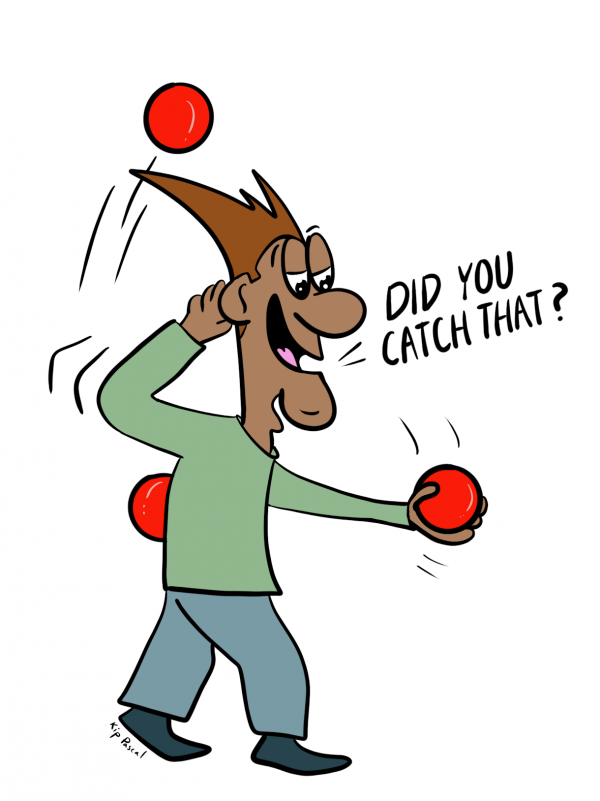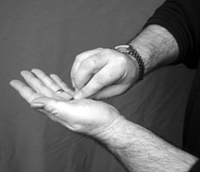JUGGLERS
Do you already perform "Broken Rhythm"
Read more below ...
|
Jugglers: Kip's Rhythm-Breaking Presentation
by Kip Pascal
It really isn't that hard to learn to break rhythm while juggling. Tim Miller, of Eugene, Oregon first taught me how in 1977.
Once you get a knack for it, you'll be able to let go of juggling balls and grab others mid-beat, almost without thinking about it.
Just like other moves, breaking rhythm really does become automatic. Even though it's a fairly easy skill to master, it makes for a very impressive juggling demonstration.

What follows is a description and the presentation of how I use Rhythm-Breaking as a segue from juggling to other topics of conversation.
The result is that you will build your reputation AND leave them wanting more.
The Set Up
I don't use this technique for large audiences.
I need the spectators to be close enough to see the hands interact with each juggling ball. It's important to the effect.
Also, look for a situation where you have the opportunity to perform a short routine and then sit back down with the spectators to talk.
Here is how the presentation might start:
While mingling at a small party, I notice three juggling sacks in a dish on a table.
Kip: Hey are these your juggling balls? They have a good feel to them -- right weight and size.
Sue: Yes, they are. I am trying to teach myself to juggle.
Kip: Let's see what you can do.
Sue: Oh no. I am no good yet. Do you juggle?
Kip: Well, my first roommate in college was a juggler. And since I was a magician, we traded lessons. Over the years, I have kept with it.
Sue: Could you show me something, please?
Kip: Sure. (I pick up the three balls and start juggling in a standard Cascade pattern.)
Kip: Is this the pattern that you are learning?
Sue: Yes, it is. But you are much better than i am. I keep having to run forward after the balls.
Kip: Sue, I could stand in front of you, while you practice. That would stop the forward motion. You wouldn't dare run into me.
Sue laughs a little.
Kip: Or I could tell you that you are letting go of the juggling sacks from the tips of your fingers. That's why you are chasing them. Throw in an upward motion from the palm of the hand and your problem will be solved.
Sue: Thanks, Kip. That's a great suggestion. Do you know any other patterns of juggling?
Kip: Like these? (As I start, some of the other guests of the party gather around to watch. I start throwing one ball back and forth over the top. I toss one behind the back. And then flow into a Shower/circular pattern. Finally, I blend back into the original Cascade -- my resting pattern)
Sue starts the applause. The others join in.
Sue: Kip, what's the hardest pattern that you know?
Kip: Well Sue, it's not really a pattern, but it is a skill. You won't see many jugglers performing this.
Another Guest: I'd like to see it.
Kip: Well, it has to do with rhythm. The next time you watch a juggler, watch the when the balls are being thrown and caught. There is a definite rhythm to the juggling. That's why they call them patterns.
The pace or rhythm is born from the pattern, so to speak. (I continue to juggle the balls in a Cascade, but now I count with each throw out loud. 1 ... 2 ... 3 ... 4 ... 5 ... 6 .... 7.)
Kip: What you won't find many jugglers performing, in fact it takes years of practice, is breaking out of the rhythm. (I then do an under throw, skip grab. I do it smoothly and quickly.)
Kip: Did you catch that, pardon the pun? I mean, did you see the broken rhythm? Here it is again. (Then I break rhythm a couple of more times, with regular pattern in between. For these beat skips, I really accentuate the motion. This way, everyone sees the quick-grab in the middle of the routine.)
Kip: If you practice this broken rhythm enough, you can accomplish something that will really blow your mind. If you practice enough, you can break rhythm often enough that your broken rhythm actually becomes its own rhythm. Here's what I mean....
(At this point, if I am around a bunch of non-jugglers, I sometimes go into a series of claws with each hand on every ball. But if some of the people in the audience are familiar with the claw, then I play it straight and start doing the under - skip beat on both sides. First, I throw under with the left hand and claw with the right. Then on the very next throw, I throw the next ball under with the right hand and claw with the left hand. I continue skipping the beat on each throw until they see the pattern. Then I bring it to a close.
Sue (commenting to another guest): Look how fast Kip's hands are. They are moving at lightning speed....
Conclusion
And that's my cue to move into the coin switch (Kip's Take from Coin Snatching: The Reputation Builder).
They get a private demonstration of a byproduct of being able to skip a beat in juggling.
They see that your hands are so fast that not only can you snatch a coin from a participant's hand, but you can secretly leave one in its place.
I do exactly what the book advises for building my reputation in this context. And it works like a charm.
Of course, you don't need to segue into a coin switch; it's what "I" do.
If you have a better way to cap your performance, feel free to incorporate your own techniques. I just know that the coin snatch, with the right presentation, is perfect at this point. (Sorry for the small sales pitch.)
Kip: No gimmicks. And as for different routines, yes, you'll find a variety, including the Upside-Down, Impossible Coin Snatch. =>
Ezine: That sounds difficult.
Kip: Actually, it's one of the easiest to perfect ... and very baffling. In fact, you'll be able to fool someone with your presentation 5 minutes after reading the explanation. (OK, maybe 10 minutes.)

Ezine: Is this a book for magicians or martial artists?
Kip: Yes ... or "Both." Coin Snatching is coin snatching, no matter who performs the effect. There are chapters specifically for magicians, but there are also chapters geared towards martial artists.
Ezine: Is this a real skill? I thought it was just "a trick."
Kip: Can I answer "sort of" on that last question? It is a trick, but there are some very good principles of efficient movement to be learned. It's a great starting point for martial artists to develop speed, eliminate unwanted telegraphs, and so forth.
Ezine: So, is it more of a "stunt" for magicians?
Kip: Well, you could present it as a magical change in a spectator's hand, and some magicians do. But I think it should be presented as a skill ... almost as a byproduct of being a magician with fast hands.
Ezine: Nice.
Kip: I agree.
Ezine: For a last question, and keeping in mind that you are biased as the author, what's your favorite chapter, trick, or part of Coin Snatching: The Reputation Builder?
Kip: That's easy. The clue is in the title. Also, we just touched on the subject by advising folks to perform it as a skill.
Ezine: Go on.
Kip: I love all of the advice on actually building your reputation. This goes way beyond simple coin snatching. Generalize the skill. The methods are so subtle, and don't cost a thing to employ. It's all about presentation.
~ END OF INTERVIEW ~
More Magic Articles
There are more articles for MAGICIANS here at CoinSnatching.com
Take a look:
"Magicians are the most honest people in the world; they tell you they're gonna fool you, and then they do it."
–James Randi
"The magician and the politician have much in common: they both have to draw our attention away from what they are really doing."
NOT Just for MAGICIANS!
Magicians often have other interests.
Read about coin snatching in the following categories:
"A good magician’s performance tells a story. Each act should build on the next, becoming ever more engaging to fill the audience with wonder. It’s a bud that unfurls into a flower, meant to woo the audience."
"Learning never exhausts the mind."
–Leonardo DaVinci
"The art of a magician is to create wonder. If we live with a sense of wonder, our lives become filled with joy."
Intro Magic Cartoon
Enter your email address to join The Magic Mentor
![]() We value your privacy and would never spam you
We value your privacy and would never spam you

